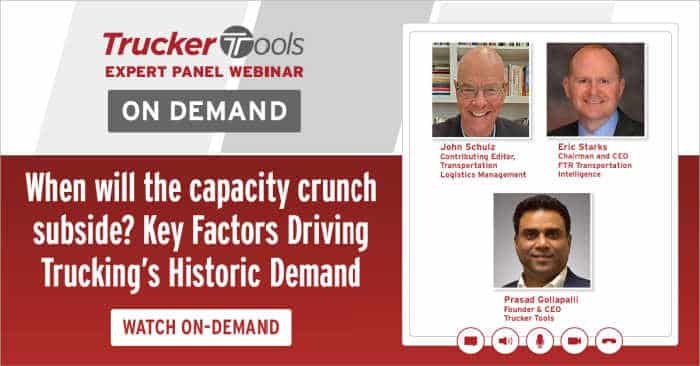Every quarter for the last year and a half, we’ve brought together experts from across the logistics and transportation industries to get their insights on current market conditions and predictions on what’s to come. We recently reconvened our panel to discuss what’s happening in freight markets and to get our experts’ recommendations on what freight brokers and logistics providers like you can do to navigate the current capacity crunch. The webinar, entitled “When Will the Capacity Crunch Subside? Key Factors Driving Trucking’s Historic Demand,” featured FTR Transportation Intelligence’s Chair/CEO Eric Starks, Logistics Management’s Contributing Editor John Schulz and Trucker Tools’ Founder and CEO Prasad Gollapalli.
Check out these key highlights from the panel’s discussion of how brokers and logistics providers can be successful during this historic capacity crunch.
How To Plan for the Future in This Environment
According to Starks, retail and food service sales during the pandemic have put tremendous pressure on supply chains and the transportation industry at large. Demand for retail goods and food service returned quickly following the initial COVID-19 related shutdowns in 2020. Current retail inventories are depleted when compared with pre-pandemic levels. A truck/car chip shortage has created a ripple effect in which it’s difficult for fleets to purchase new trucks to add additional capacity. All of the above has created a record-breaking capacity crunch in the trucking industry with record-breaking rates.
In the webinar, Schulz discussed some of the high freight rates that shippers, brokers and 3PLs are seeing across popular lanes and had these words of advice for companies who are trying to weather the capacity crunch and high rates.
“The Chicago spot market volume is up 40 percent over the past four weeks,” said Schulz. “The average outbound van rate in the spot market from Los Angeles to Phoenix hit $4.61 last month. That is a significant per mile rate. It’s a carriers’ market and they’re being very selective in who they do business with. This is a relationship industry. It’s a technology industry. Now is the time to call in your best technology and call in your best relationships to obtain capacity. Capacity is tight and the capacity situation is going to remain tight for the foreseeable future. The old ways of securing capacity and playing one carrier off of another are not going to work in the near term. Shippers and brokers have to plan their budgets and their operations accordingly using the best technology they can find and the best people they can find. It’s not rocket science, but it’s it takes commitment to secure capacity in in this type of environment.”
“The Chicago spot market volume is up 40 percent over the past four weeks,” said Schulz. “The average outbound van rate in the spot market from Los Angeles to Phoenix hit $4.61 last month. That is a significant per mile rate. It’s a carriers’ market and they’re being very selective in who they do business with. This is a relationship industry. It’s a technology industry. Now is the time to call in your best technology and call in your best relationships to obtain capacity. Capacity is tight and the capacity situation is going to remain tight for the foreseeable future. The old ways of securing capacity and playing one carrier off of another are not going to work in the near term. Shippers and brokers have to plan their budgets and their operations accordingly using the best technology they can find and the best people they can find. It’s not rocket science, but it’s it takes commitment to secure capacity in in this type of environment.”
Alternatives for Brokers When Capacity Isn’t Available
“When you have no capacity available, the rate discussion is almost irrelevant,” said Starks. “You really have to move that out of that discussion and look at the problems you’re running into. Is it that you need to keep your facility running? How is that facility working that you’re trying to supply? What is it that you need? You can start thinking about how you run your operation and create some productivity with incentives for carriers. If you think about it, usually some of the problems are at shipping facilities. You don’t have the person there to unload you. You can’t find the right dock. You don’t have a bathroom facility readily available for the driver. Just things like that. You as a broker can actually start having some of those discussions and figure out what you can do to incentivize capacity to come to you. You need to think about how you can incentivize quality drivers and quality companies to come to you.”
“When you have no capacity available, the rate discussion is almost irrelevant,” said Starks. “You really have to move that out of that discussion and look at the problems you’re running into. Is it that you need to keep your facility running? How is that facility working that you’re trying to supply? What is it that you need? You can start thinking abouthow you run your operation and create some productivity with incentives for carriers. If you think about it, usually some of the problems are at shipping facilities. You don’t have the person there to unload you. You can’t find the right dock. You don’t have a bathroom facility readily available for the driver. Just things like that. You as a broker can actually start having some of those discussions and figure out what you can do to incentivize capacity to come to you. You need to think about how you can incentivize quality drivers and quality companies to come to you.”
Schulz agreed, saying that brokers and 3PLs need to get away from beating carriers down over rates and having a nickel-and-dime mindset with carriers. Instead, focus on total cost. If you had to shut down an assembly line, what would that cost you? If you run short of inventory at a retail location, what will that cost? Schulz contends that carriers want consistency. When you shift the number of loads you want a carrier to transport from week to week, it wreaks havoc on their planning departments and makes it impossible for them to guarantee capacity in that situation. You have to be dependable and reliable, and you have to do what you say you’re going to do, advised Schulz.
How Technology Can Ease the Capacity Crunch
“What strikes me is the speed of the current technology and also the low cost,” said Schulz. “It’s a two way street. Carriers can inform the shipper and the broker if a load is going to be late. As a broker, if you’ve promised 40,000 pounds of freight to a carrier and you only have 18,000 pounds, what you can do with that additional capacity is very, very important. It’s important at any time, but today with capacity at a premium and the system just running completely full out, there’s no excuse for not using technology to notify all parties of changes. It just smooths things out all the way around. In our magazine, we have harped on this for decades: make your operation efficient and use technology. Use all the tools in the toolbox to make life easy.”
“What strikes me is the speed of the current technology and also the low cost,” said Schulz. “It’s a two way street. Carriers can inform the shipper and the broker if a load is going to be late. As a broker, if you’ve promised 40,000 pounds of freight to a carrier and you only have 18,000 pounds, what you can do with that additional capacity is very, very important. It’s important at any time, but today with capacity at a premium and the system just running completely full out, there’s no excuse for not using technology to notify all parties of changes. It just smooths things out all the way around. In our magazine, we have harped on this for decades: make your operation efficient and use technology. Use all the tools in the toolbox to make life easy.”
In the webinar, Starks stated that technology has a huge role to play when there’s a capacity crisis. Technology allows you to cover a load faster, provides real-time visibility on active loads, and helps you understand how each part of your operation functions and the ripple effects that occur when there are disruptions. With technology, you can make adjustments on the fly. Today’s technology also can help carriers run more efficiently, which creates new capacity in the market.
“The technology out there today really has the ability to help the carrier increase productivity and so anything that can be done to increase that productivity adds additional capacity back in the marketplace,” noted Starks. “If you could do a better job of load matching and make it so carriers don’t have to run empty miles, it helps ease the capacity crisis. Technology is such a huge part of how we mitigate some of these impacts of the capacity crunch. You’re not going to get rid of it. What you’re talking about is risk mitigation here and that for me is the biggest thing you’re always assessing.”
For the rest of the panel’s discussion, watch the webinar “When Will the Capacity Crunch Subside? Key Factors Driving Trucking’s Historic Demand on demand. Schedule a free demo of Trucker Tools’ digital freight matching, real-time visibility platform and Book It Now®.






